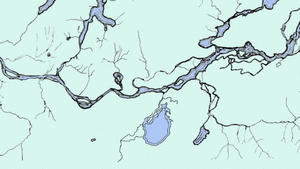Sumas Lake facts for kids
Quick facts for kids Sumas Lake |
|
|---|---|

Panorama of Sumas Lake taken by Leonard Frank
|
|
| Location | Abbotsford, British Columbia, Chilliwack |
| Coordinates | 49°04′N 122°05′W / 49.07°N 122.09°W |
| Basin countries | Canada |
| Surface area | 3,600 ha (8,900 acres) |
| Settlements | Sumas Prairie |
Sumas Lake was once a large, shallow freshwater lake in British Columbia, Canada. It was surrounded by many wetlands, which are like marshy areas. The lake was known by different names in local Indigenous languages: Semá:th Lake in Halkomelem and Semáts Xácho7 in Nooksack.
This lake was very important to the Sumas First Nation, a group of the Sto:lo Nation. It was part of their traditional lands, located between Sumas Mountain and Vedder Mountain. Today, this area is between the cities of Chilliwack and Abbotsford.
Sumas Lake was a lively home for many animals. It had fish like sturgeon, trout, and salmon. Larger animals such as grizzly bears and different types of geese also lived there. The wetlands around the lake were a perfect spot for migratory birds to rest and for fish and waterfowl to lay their eggs. Even white-fronted gooses, whistling swans, and Hutchins geese visited the lake. Its sandy shores were also special places where sturgeon could lay their eggs.
The lake provided food and supported the way of life for the Sumas First Nation. Their daily lives were closely connected to the lake and its resources. Later, in the late 1800s, European naturalists became interested in the lake. They studied and recorded the different plants and animals living there.
After the 1930s, the land where the lake once was got sold. It was turned into farms, homes, and businesses. The former lake bed stretched between Sumas Mountain in British Columbia and another Sumas Mountain in Washington State, which is part of the Cascade Mountains. A railway bridge, called a trestle, used to cross the lake. This bridge is now part of a dyke that still stands today.
Why Was Sumas Lake Drained?
In the early 1900s, people wanted to create more land for farming. An engineer named Fred Sinclair came up with a plan to drain Sumas Lake. This project started in the 1920s.
How the Lake Was Drained
By 1924, a big change happened:
- The Vedder River was moved into a new path called the Vedder Canal.
- Then, the lake's water was drained through the Sumas Lake Canal.
- This canal carried the water into the Fraser River.
This process completely changed Sumas Lake. It turned the lake bed into what is now known as the Sumas Prairie, a large area of farmland.



